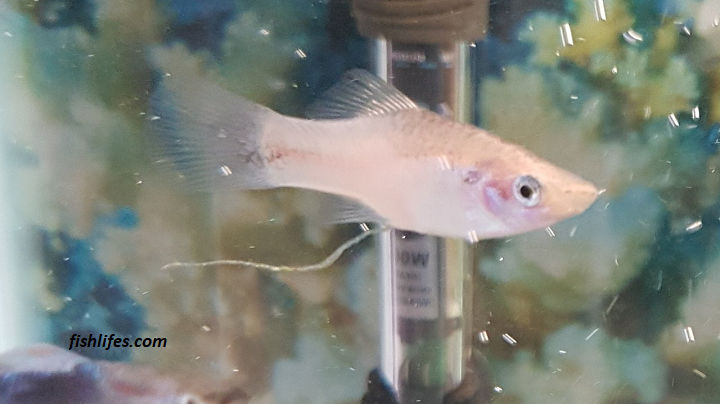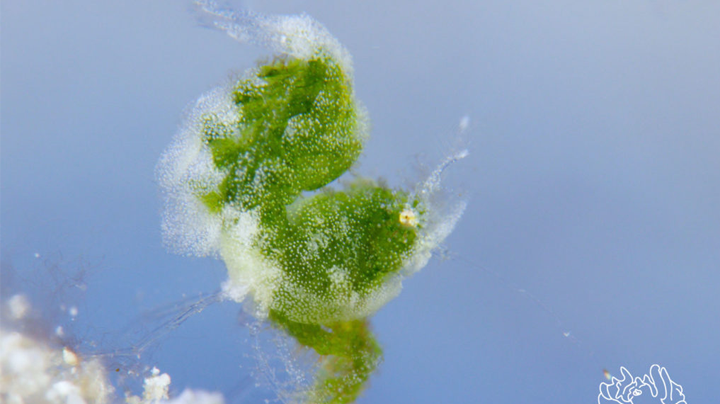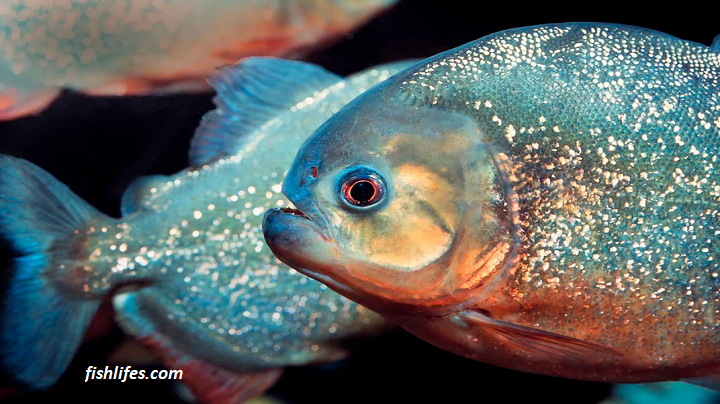The Jaguar Cichlid is a magnificent and powerful fish that can make a great addition to your aquarium. This aggressive fish requires careful attention and care, as, without it, they can become hostile toward other tank inhabitants.
However, these majestic creatures can easily be kept in an aquarium with proper knowledge. In this article, we will provide you with the necessary tips and tricks to care for a Jaguar Cichlid while keeping them passive in its environment.
Jaguar Cichlid
The Jaguar Cichlid, or Parachromis amanuensis, is a fish native to Central America and can be found in lakes, rivers and streams. This cichlid species has a distinct patterning on its body with light blue circles covering its dark brown base colour.
The large spots give them their name as they resemble the markings of a jaguar. They are one of the largest species in the cichlid family, growing up to 16 inches long in some cases.
These aggressive fish make them popular with experienced aquarium hobbyists who like challenging themselves with difficult tank mates. Many hobbyists consider these cichlids attractive due to their unique colouring and patterning, making them famous tank showpieces.

How big do Jaguar Cichlids get?
Native to Central America, it can reach impressive sizes when given the proper care and environment. If cared for correctly, these fish can grow up to 12 inches long and weigh up to one pound!
When it comes to size, jaguar cichlids have a lot of potentials. These large and often colourful fish are medium-sized compared to other cichlids but can still make quite an impression in larger tanks or ponds.
While some may stay relatively small if only provided little food or space, those kept in optimal conditions will reach their full potential in no time.
Is Jaguar Cichlid Aggressive?
Yes, it is an aggressive fish species. This Central American cichlid is also known as the “Jaguar Guapote” and can reach up to 15 inches in length.
With its attractive markings and large size, this species makes a bold statement in any aquarium.
Although it is considered semi-aggressive compared to other cichlids, it should not be housed with smaller or more timid fish due to its territorial nature.
Jaguar Cichlid Behavior
This colourful, large fish has an undeniable personality and can be quite an exciting addition to any home aquarium. Owners need to understand their Jaguar Cichlid’s behaviour patterns to care for it properly.
Jaguar Cichlids are known for being territorial and aggressive towards other fish, especially those similar in size or appearance. This behaviour can make them challenging to house with other species due to potential fights, but they tend to interact well with conspecifics when kept in groups. They will even challenge much larger species and humans if they feel threatened.
How long do Jaguar Cichlids live?
These stunning, colourful fish make an attractive addition to any home tank and can live for several years with proper care. Knowing how long your particular Jaguar will live is essential for providing the right environment and food sources.
On average, Jaguar Cichlids have a lifespan of 8-12 years when kept in favourable conditions. In larger well-maintained tanks with high water quality, these fish may even live up to 15 years or longer!
To give your Jaguar Cichlid the best chance of reaching its total life expectancy, it’s important to provide plenty of hiding places and enrichment tools like plants, rocks and driftwood for optimal mental stimulation.

One look care Guide
| Scientific name | Parachromis managuensis |
| Common name | Managuense Cichlids or Aztec Cichlids,Jaguar cichlids |
| Care level | Moderate to hard |
| Native to | Central America |
| Temperament | Very aggressive |
| Recommended tank mates | Jaguar cichlid Oscar fish Green Terror cichlid convict cichlid Red devil cichlid Flowerhrn cichlid |
| Preferred food | Carnivorous food |
| Feeding frequency | Once a day |
| Type | Freshwater |
| Growth rate | Speedy |
| Size | 14- 16 inches in captivity,2 feet in the wild |
| Preferred salinity | Freshwater |
| Other water parameters (ammonia, etc.) | pH: 7.0 to 8.7Hardness:10-15 GH |
| Prefered temperature | 73°F to 82°F |
| Tank size | 70 gallons |
| Colour | Black and white |
| Breeding | Egg layers, easy to breed in captivity |
Jaguar Cichlid Care
Jaguar Cichlid Size
One of the most important elements of Jaguar Cichlid care is understanding its size.
At full maturity, a single Jaguar Cichlid can reach lengths up to 18 inches long.
Jaguar Cichlid Tank Size
Regarding tank size for Jaguar Cichlids, specific requirements must be met to ensure the health and well-being of your fish.
For younger jaguar cichlids, an average size of 30 gallons (113 litres) will suffice; however, as they grow larger, they may need more space.
A good rule of thumb is one gallon per inch (2.54cm) of full-grown fish length. 75-100 gallons (283-378 litres) is recommended for adults.
How many Jaguars Cichlids should be kept together?
When it comes to keeping multiple Jaguar Cichlids in one tank, the answer may vary depending on the size of the aquarium and its inhabitants.
When considering how many Jaguar Cichlids should be kept together, it is essential to remember that they are territorial by nature and can become aggressive when crowded.
Large tanks of at least 55 gallons should be used with one male and 2-3 females so they have enough room to establish their territories without risk of fighting. This will also give them enough space to swim freely without feeling threatened or overcrowded.
Tank Setup
Proper tank setup is essential when keeping Jaguar Cichlids to ensure their health and well-being.
When setting up the aquarium for your new Jaguar Cichlid, it’s essential to provide plenty of swimming space so they can roam around without feeling confined or overcrowded.
An ideal tank would be at least 100 gallons with a depth of approximately 24 inches. You should also use a sand substrate as it helps maintain the water’s pH level, which these fish prefer between 7-8 on the pH scale.
Experts recommend that the aquarium be at least 50 gallons and have plenty of hiding places, such as caves or rock formations. If possible, use dark substrate and floating plants to mimic their natural environment.
When setting up a tank for your Jaguar Cichlid, it is important to include plenty of rocks and logs as they provide hiding spaces and surfaces on which the cichlids can spread their territory-marking pheromones. Plants should also be added, with plastic being preferred over natural plants as the jaguar cichlid has been known to dig them up or eat them entirely.
Water Quality Condition
To keep this species healthy and happy in an aquarium, careful attention must be paid to its water quality conditions.
Water quality for the Jaguar Cichlid should maintain a temperature between 77 and 86 degrees Fahrenheit, a pH level between 7.8 and 8.6, a hardness between 100-200 ppm, carbonate hardness (KH) between 8-12 dKH and nitrate levels below 20 ppm.
To keep these parameters at optimal levels, monitoring water chemistry regularly with test kits or through local fish stores or professionals who provide testing services is important.

Jaguar Cichlid Breeding
Jaguar Cichlid male or female identification
For aquarium hobbyists, breeding Jaguar Cichlids is a fun hobby because of the fish’s distinctive colours. It might be challenging to differentiate between male and female Jaguar Cichlids, but some characteristics can be used to make the distinction.
The size is the first thing that stands out because men often grow bigger than women. Additionally, males have anal fins that are more pointed, while females have rounded ones. Males also have a longer dorsal fin with brighter colours.
While females may have comparable colour, it is often less intense than males. Furthermore, compared to their male counterparts, who remain slim throughout their lifetimes, female Jaguar Cichlids become rounder significantly when they are ready to procreate.
Identify Pregnant Jaguar Cichlid and Jaguar Cichlid Pregnancy stage
Pregnant jaguar cichlids are some of the most stunning and alluring fish in freshwater aquariums. In contrast to other species, jaguar cichlids do not usually show indicators of pregnancy, making it challenging to spot a pregnant one.
Understanding how to spot a pregnant jaguar cichlid and the stages of its pregnancy is crucial for those trying to monitor the gestation process.
Examine your female jaguar cichlid for an expanded abdomen and darkening stripes to see whether she is pregnant. As the eggs grow inside her body, you’ll see that her body shape will start to change over time.
Jaguar Cichlid Breeding
Breeding them in captivity requires some dedication and patience but is a rewarding experience that hobbyists of all skill levels can enjoy.
Breeding a pair of Jaguar Cichlids can be fun and rewarding, but it is important to remember that these fish must find their partner and naturally pair off for successful breeding.
When adding a pair of Jaguars for breeding purposes, selecting two healthy individuals from the same species is essential. For successful breeding, it is generally best to introduce a male and female into the tank, where they can form a bond before any eggs are laid.
Once this bond has been established between two compatible individuals, they will begin regularly spawning within their home aquarium environment.
When it is time for breeding, the female will lay her eggs on a flat surface, such as a rock or log. The male will guard the eggs until they hatch two to three days later.
After hatching, he will remain close by and protect them from potential predators while they are still vulnerable. Once they become more independent, both parents may help feed them and watch their young ones to ensure their safety.
The most important factor when breeding Jaguar Cichlids is maintaining ideal water quality. This should include performing 50 percent water changes regularly and checking pH and temperature.
During spawning season, females can lay upwards of 2,000 orange eggs at once!
When the fry emerges after hatching, they must be provided with plenty of hiding places and food sources, such as small crustaceans or live foods like brine shrimp.
Jaguar Cichlid fry care
When caring for jaguar cichlid fry, some essential elements must be considered:
They prefer warm water, with temperatures around 80-84°F and a pH level between 6 and 7.5 is ideal.
They require plenty of hiding places, such as live plants or rock caves, to feel safe from predators.
Their diet should consist of small live foods such as brine shrimp or bloodworms, providing them with essential nutrients for growth and development.
Diseases
Despite their attractive appearance, they can suffer from various diseases if not provided with well-maintained water conditions.
Common diseases that affect Jaguar Cichlids include Ichthyophthirius multifiliis (also known as “Ich”), caused by a parasitic infection;
Columnaris, caused by a bacterial infection; and Hole in the Head disease, which is caused by inadequate nutrition. These ailments can be prevented or treated with the proper tank maintenance or medication, but significant damage may occur if left untreated.
Feeding Behavior of Jaguar Cichlid
What do they eat?
In the wild, these fish primarily feed on insects, crustaceans, mollusks, and small vertebrates. However, when kept in aquariums, they can be fed various foods.
Providing a balanced diet that includes proteins and vegetable matter in an aquarium setting is essential.
High-quality pellets should make up the bulk of their diet, along with frozen Mysis shrimp or bloodworms as occasional treats. Vegetables such as zucchini slices can also be offered several times a week to ensure they receive enough fibre in their diet. For maximum nutrition, live foods like brine shrimp or daphnia should also be provided occasionally.
How often should you feed?
The jaguar cichlid is a tropical fish renowned for its stunning tail and vivid markings. It is a standard option for aquarium fans and can be found in rivers around Central America. But how frequently ought one to feed a jaguar cichlid?
Understanding your jaguar cichlid’s natural feeding habits is the key to choosing the right food amount.
They are opportunistic bottom feeders who consume any available wild food. This means that instead of feeding them a substantial meal every few days, they should receive multiple tiny meals throughout the day. A decent rule of thumb is to give them as much food as they can in two minutes once or twice a day.
When should you feed (time of the day)
You should always feed your jaguar cichlids at the same time every day. How frequently you need to feed them and when they should eat depend on the type of food you are giving them. In general, captive specimens need two to three meals each day, each lasting no longer than two minutes.
How long they can go Without food?
The individual fish and its surroundings will determine the response. Jaguar cichlids can typically go up to two weeks without eating and keep a healthy body weight. This does not imply that keepers should forgo routine feedings; instead, giving your fish a balanced diet of proteins and vegetables at least three times a week is critical.
What Fish can live with Jaguar Cichlid?
If you’re considering adding a Jaguar Cichlid to your tank, it’s essential to make sure any potential tankmates are compatible. So what fish can live with Jaguar Cichlids?
When selecting which fish can cohabitate peacefully alongside the Jaguar Cichlid, it’s important to remember that these cichlids can become territorial and aggressive when they reach maturity.
Generally speaking, larger species such as Oscar Fish or Bala Sharks will get along with the Jaguar Cichlid as long as they have plenty of space in the aquarium.
The Oscar fish is one of the best tank mates for the Jaguar Cichlid.
The Oscar’s larger size and active swimming style allow it to hold against even the most aggressive Jaguars. Other good companions include Green Terror cichlids, similar in size and temperament, and convicts cichlids, much smaller than their counterparts but share some of their boldness.
Summary
In summary, the Jaguar Cichlid is one of the fish species with the most spectacular appearances and an excellent addition to any home aquarium.
They can be kept safe and healthy and bring their owners years of pleasure and enjoyment with the proper care.
It’s crucial to remember that this fish is aggressive, so you must take the required precautions to ensure it gets along well with its other tankmates.
Related Questions
Are female jaguar cichlids aggressive?
Yes, female jaguar cichlids are aggressive. They are territorial and will defend their territory from other fish in the tank. They may also be aggressive towards other female cichlids of the same species, so keeping only one female in a tank is best.
What size tank do Jaguar cichlids need?
Jaguar cichlids need a minimum tank size of 55 gallons, although larger tanks are preferred. They are active swimmers and require plenty of swimming space. The tank should also be well-filtered and have plenty of hiding spots to provide them with security.
Do cichlids prefer sand or gravel?
Generally, cichlids prefer sand as it is softer and more comfortable. Additionally, sand allows them to dig and create their territories, which they naturally want to do. Gravel can be used in the aquarium, but it should be refined so that the cichlids can still dig and create their territories.
Something more for you:







